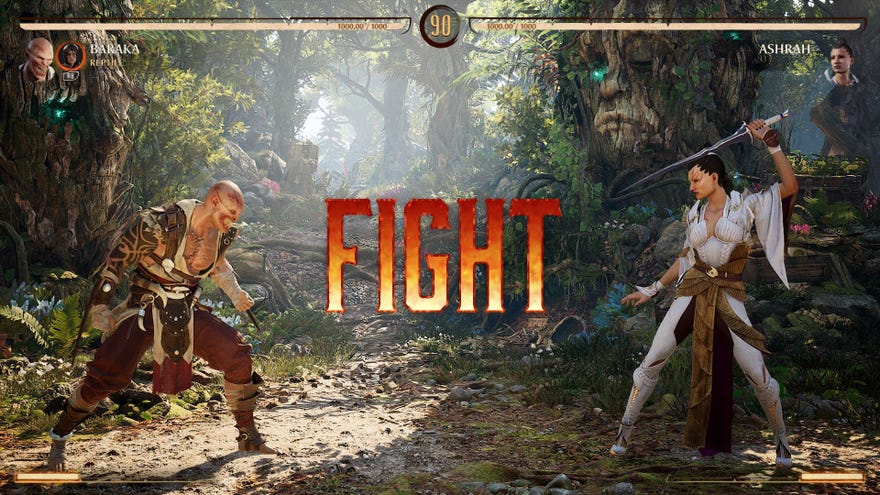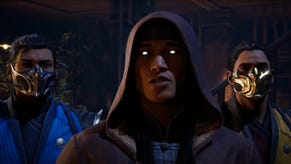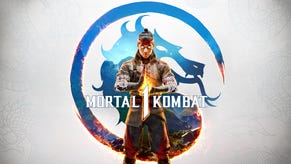Mortal Kombat 1 review: klassic killing meets kampaign kliché
Everyone's a kritic
With its steadfast love of imploding skulls and disintegrating ribcages, Mortal Kombat has always been the most adolescent of fighting games. Mortal Kombat 1 might be using its conspicuous numeric digit to suggest a reset or rethink of some kind, but in truth it isn't remotely concerned with reinventing its world of misfits. While part of me wishes this surface-level overhaul had been more radical, it's maybe unwise to expect that. For decades this series has embraced its love of brainless ultraviolence and childish storytelling. If Mortal Kombat 1 can be praised for anything, it is unwavering kommitment to the bit.
First off, don't flip out. The fighting itself is still decent. The move list for each character is a clean and digestible three-course meal compared to, say, the all-you-can-barf-smorgasbord of Tekken's character movesets. In true 2D fighter form it encourages a versatility of violence with a limited palette. And it works. One Sindel you face online will make teleporty dive kicks the backbone of her assault, while another Sindel might rely more heavily on cartwheeling mix-ups - but every hair-whipping Queen will throw out the basics. The fun of any fighting game is derived from the mixture of panic and anticipation that comes from trying to figure out which gory murdermoves your foe likes too much. And Mortal Kombat 1 still delivers in this regard.
Whether it delivers that sensation as finely as its predecessor is another matter. For some indescribable feeling in my fingertips, it doesn't seem as impactful or fierce to me as Mortal Kombat 11 did. But that is a hard act to follow, and it does strive to make up for that with some twists. Namely, the introduction of "Kameo" fighters, off-screen characters who briefly pop into the fight at the drop of a button. The idea isn't new to fighting games, but it is at least well-implemented here.
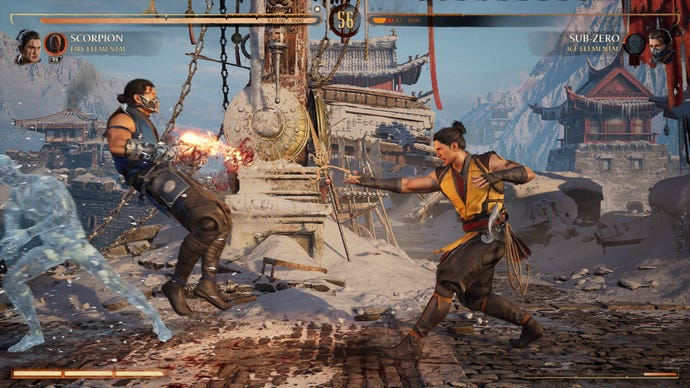
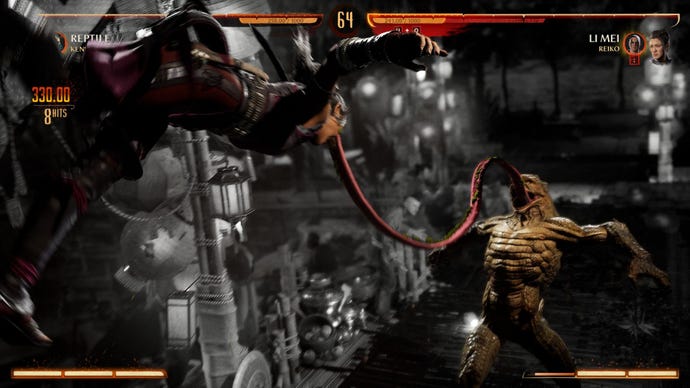
For example, a Kameo blow from a twirling Kung Lao can begin or supplement your horrendous combo, while other Kameos act as a kind of panic function. Scorpion as a backup fighter can use his Ropey Knife™ to pull you away from your enemy, letting you dodge incoming strikes. Sub-Zero as a biff-buddy can embalm you with temporary ice armour that blocks projectile attacks, perfect for handling zoney sneaks who launch fireball after fireball from afar. With some judicious reflexes (read: panicked button-mashing) these Kameos also show up to break you out of an opponent's combo at the expense of some meter, similar to the "breakaway" effect of the previous game (but with the added pleasure of seeing Frost dropkick your enemy across the room).
Online fights are still the purest distillation of the game's juice. The casual mode wasn't super populated this past week (pre-order scabs got the game a week early), so I've had to stick to ranked mode, flipping the unfortunate psychological switch in my brain marked "to fail brings shame". Salt-inducing personality quirks aside, online fights offer that familiar Karate Kid self-improvement ladder of learning that distinguishes the genre as the competitive perfectionist's ideal pastime. In short: I lost a lot, yet did not stop.
On a technical level my online fights have been free of issues, but there are quiet groans of frame drops and other problems affecting scraps. Even for me there were noticeable stutters every few seconds during story cinematics, alongside a certain fuzziness. Both these issues were fixed with some Nvidia control panel tweaking, which is not ideal, but not exactly an affront to humanity either. This is PC gaming after all. Either way, the full scale of technical problems probably won't be known until the masses get to battering. Consider this a friendly caution.
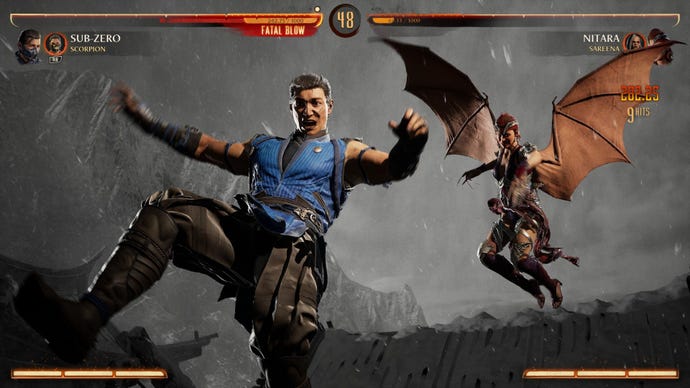
In any case, that's the least of the singleplayer story's problems. There's off-kilter voiceover, uncanny valley mocap moments, and annoying button-mashing "test your might" quicktime events (you can turn these off in the options, thank the Elder gods). Rather than being a remake as the brassy number "1" suggests, it is basically a giant narrative hangover resulting from the punchdrunk finale of the previous game. Liu Kang is now a god and he has reinvented the universe. But not that much. What follows is a generic story of side-switching, fan service, and endless kliché with a K. You will speak half of the script out loud seconds before the characters do. Kase in point:
"I never thought that-"
"That's your problem, Mileena! You never think!"
No character is more aggravating than Johnny Cage, who spends most of his time standing behind other people making dated pop culture references. I understand the need to communicate that a character is obnoxious to allow for their development and maturing, but A) that is the same character arc Johnny had in the previous game and B) you only need to communicate this a couple of times. He doesn't need to make a weak quip in every scene.
Given the chance to reinvent, the story chooses only to readjust, casting some villainous characters as good guys, and introducing an over-excited passion for the word "timeline". Like a lot of pop culture today, it conjures the tepid spectre of the Marvel Cinematic Universe, indulging in senseless multiverse masturbation. Less a reboot, more a pseudoboot. "Two timelines..." worries one of the heroes. "Never in a billion lifetimes have I seen this." Unfortunately, anyone who has been to the cinema in the last ten years cannot say the same.

But look at me, getting upset about a fighting game's story mode. That it takes nothing seriously is both a weakness and a strength. It means the dialogue and characterisation isn't very thoughtful, sure. But it also leaves the action open to kung fu comedy moments, like when a bystander at the bar nonchalantly takes a chunk of ice from Sub-Zero's whiffed attack to use in his drink. At one point, during a feast in the fantastical Outworld, the tiny Earthrealmers gorge themselves with plates stacked high, while monstrous ogrebeings like Shao Khan watch on in disgust with a modest plate of vegetables. The storytelling throughout is so childlike, so like watching a gaggle of primary school kids playing make-believe, that when the characteristic violence occurs and eyes are gouged out, or arms are torn off, it too lends the scene a kind of howling and perverse comedy.
And even with my multiverse komplaints, there is a genuinely interesting payoff to that guff in the final chapter. (Warning: here be spoilers). At a pivotal moment, the timeline nonsense brings out a gauntlet of hybrid foes that you have to fight. I'm talking Nitara with Sub-Zero's freezing powers, a Tarkatan Johnny Cage with boney knife arms, Goro wielding four hammers normally reserved for Shao Khan, one in each of his bulging sausage arms.
The strenuous buckling of plot that leads to this explosion of khaotic kharacter kimeras is insensible, but this sequence of final fights is exciting and unpredictable in a way the story otherwise rarely is. For my money, that final half hour is the most inventive part of the single player by a mile, and if it results in some kind of character mash-up mechanics being worked into in Mortal Kombat 2: The 2nd then it may all have been worth it.
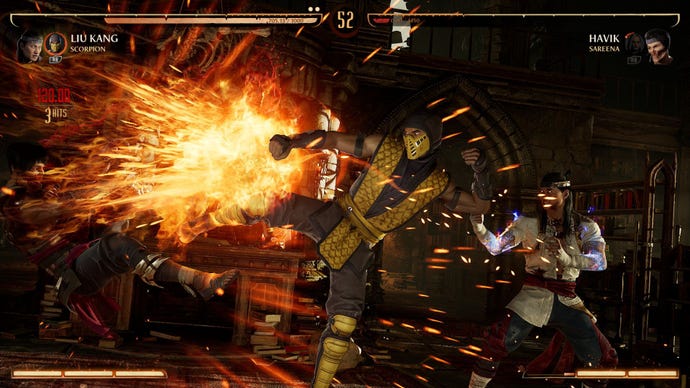
There are other things I admire about this installment. The background environments are vibrant and filled with detail, for example. There's a tea house where seated bystanders scuttle away when the fight comes close to them. Treasure vaults filled with gleaming gold. A laboratory with a wretched experimental fleshdude, who watches you sadly as you fight. The story mode might often be hokum but, as with its predecessor, I can't deny the level of craft and finesse that has gone into recreating arenas. They manage a healthy balance of eye-pleasing detail and non-distracting simplicity that's essential in a fighting game, and often underappreciated.
In short: good fightin', rushed writin'. The storytelling is markedly more generic than the previous game (even that was a bit too Marvel for me), and I'm less in love with the character design overall. I miss the big ringed chrome arms of Jax, for instance, the skittering sharpness of D'vorah's spikey limbs, or Kollector's blessedly messed-up arm anatomy (he's not playable so far). So for franchise-agnostic fighting game dweebs, it might not capture the imagination with the same might as its predecessor. But otherwise there's enough klassicism to Mortal Kombat 1 (and enough fan servicey callbacks) to please the diehards. A totally acceptable (akkceptable?) follow-up, provided the online kombatants follow through.
This review is based on a review build of the game provided by publishers Warner Bros Games.
